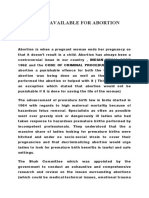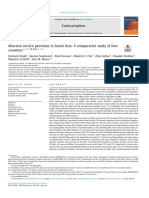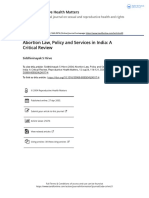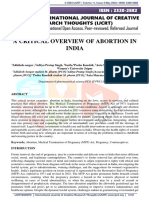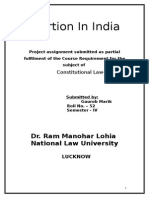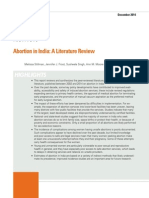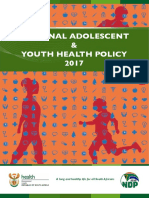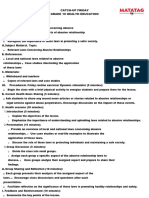Abortion Assessment Project – India: Summary and Key Findings
Dr. Mala Ramanathan and Dr. P Sankara Sarma (Editors)
For many decades now maternal health has been recognised as a crucial area of concern. In this
context, incidence, access, safety, legality, cost, social and cultural dimensions, and women’s
control over decision and choice and other related issues regarding abortion and abortion
services in India have assumed serious concern in the context of women’s reproductive health
needs. The Abortion Assessment Project-India (AAP-I), an all-India research study that
commenced in August 2000, was initiated with the objective of assessing ground realities through
rigorous research. The overall objectives of the project were:
• Review Government policy towards abortion care, and policy/programme environment in the
country1
• Assess and analyse abortion services, including organisation, management, facilities,
technology, registration, training, certification and utilisation in the public and private sector2.
• Study user perspective with special focus on women’s perceptions of quality, availability,
accessibility (including barriers to utilisation of safe abortion facilities), confidentiality,
consent, post-abortion contraception and attitude of service providers3.
• Study social, economic and cultural factors that influence decision-making: impact of
changing social values, male responsibility, family dynamics and decision-making4.
• Estimate rate of abortion, resultant morbidity and mortality; causes of spontaneous and
reasons for induced abortion5.
• Document cost and finance issues related to the above6.
• Disseminate information on abortion issues widely and develop an advocacy strategy on
issues of concern in the context of reproductive rights of women.
To achieve the above objectives a wide range of studies with differing methodologies were
undertaken. Given the prevailing situation of abortion services and the changing perception and
values of the community, a national assessment study should not only cover a wide geographic
area but also try to capture the various dimensions of the problem. There were five dimensions of
this study:
I. Overview paper on policy related issues, series of working papers based on existing data
/ research and workshops to pool existing knowledge and information in order to feed into
this project. (Component I);
II. Multicentric facility survey in six States – Kerala, Rajasthan, Haryana, Madhya Pradesh,
Orissa and Mizoram(Component II)
III. Eight qualitative studies on specific issues to complement the multi-centric studies. These
have been done by researchers, grassroots groups and medical establishments in six
states – Tamilnadu, Karnataka, Andhra Pradesh, Maharashtra, Gujarat, and Haryana.
Also a multicentric qualitative study of informal providers was undertaken in Rajasthan,
1 See Siddhivinayak Hirve (2004), Abortion Policy in India – Lacunae and Future Challenges,
Abortion Assessment Project India, CEHAT and Healthwatch, Mumbai
2 See facility survey reports of 6 states and the national synthesis report – under publication, CEHAT
and Healthwatch, Mumbai
3 See Qualitative Studies – A Report (2004), Healthwatch and CEHAT, Delhi; and Household study
reports from Maharashtra and Tamil Nadu - under publication, CEHAT and Healthwatch, Mumbai
4 Ibid
5 See houshold study reports from Maharashtra and Tamil Nadu – under publication, CEHAT and
Healthwatch, Mumbai
6 Ibid
� Maharashtra, Madhya Pradesh, Karnataka, Uttar Pradesh, Haryana and Delhi
(Component III);
IV. Community based studies to estimate abortion rate and out-of-pocket expenditures in
Maharashtra and Tamil Nadu (Component IV).
V. Dissemination and advocacy programme through workshops, consultations and
meetings with various stakeholders and analytic literature/publication dissemination both
via academia and NGOs and through popular media (Component V).
Over the last decade abortion has indeed become a major global issue in the context of
reproductive rights of women. Worldwide of the 210 million pregnancy outcomes each year 46
million or 21.9% are estimated to be induced abortions. These are very large numbers and given
the context of wide-ranging restriction on free use of abortions in a number of countries and also
an outright ban in many countries, the risks faced by women who are often forced to use unsafe
alternatives is tremendous and this is reflected in 13% of maternal mortality worldwide being due
to unsafe abortions7. Given this scenario the women’s movement and health groups have taken
up proactively various concerns related to abortion.
In the last decade women’s health advocates have tried to draw the attention of policy makers
and administrators to a range of issues related to abortion in order to improve the availability,
safety and use of services, including:
• Abortion perceived as an extension of the Government’s population stabilisation programme;
• Tendency to use abortion as yet another means of family planning;
• Growing trend in some parts of the country towards sex selective abortion;
• Inadequate safe abortion facilities within reach of the majority of poor women in rural and
urban areas;
• Dearth of medically approved abortion providers and registered facilities;
• Inadequacy of post-abortion family planning counselling and services; and
• Abortion not perceived as a women’s health issue among policy makers and service
providers;
Government of India’s decision in the post Cairo period (1996) to introduce a more
comprehensive Reproductive and Child Health (RCH) program in place of the vertical safe
motherhood, child survival and family planning programs gave women’s health advocates an
opportunity to re-establish the importance of a holistic approach. Donors supporting the
Government’s efforts (UNFPA, WHO, European Community, SIDA, DANIDA and DFID) highlight
the importance of looking at abortion-related mortality and morbidity as a part of the RCH
package. This has created a favourable climate in the country to examine the issue from different
dimensions and work towards making abortion safe. In the last six years donors have been
working with the Government of India and various State Governments to develop district-specific
plans for Reproductive and Child Health Programs. The first phase of the RCH program is now
coming to an end and plans for the next phase are being finalized. While the first phase of the
RCH program may have limited achievements, greater participation of larger number of
stakeholder in its review and the next phase planning shows willingness on the policy front to
move ahead. These efforts have been noteworthy and administrators are trying to grapple with
hitherto unexplored public policy issues. With regard to abortion, despite the US gag-rule, during
the first phase of the RCH program some important changes in the MTP Act and Rules related to
certification, penal provisions and medical abortion have been made. Also the struggle by
activists with regard to sex-selective abortions has moved up this issue in the state agenda and
implementation within the states of the PNDT has improved substantially. Also the Government of
India has recently passed the completely amended PNDT Act, which now also covers pre-
conception techniques.
7WHO: Safe Abortion – Technical and Policy Guidance for Health Systems, World Health
Organisation, 2003, Geneva
�While the climate seems to be favourable to initiate debate on safe abortion among key
stakeholders, lack of reliable information, wide regional variations, rural-urban differences and a
thin research base, make it difficult for policy makers, administrators and women’s health
advocates to develop strategic interventions. There is little dialogue between different
stakeholders and it is not uncommon to see registered service providers, unregistered / untrained
practitioners, women’s health advocates, population control lobby, public health advocates and
others working at cross purposes. While the moderate spectrum in all the above constituencies
are open to dialogue and change, it is indeed a big challenge to bring them together in a non-
confrontational forum.
The policy review, working papers and various studies undertaken in this project highlight the
inadequate attention given to abortion within the health and population policy of the country and
reiterates the often voiced concern that even the recent Reproductive and Child Health
programme, initiated by GOI in 1997, has failed to address issues related to abortion.
Key findings
1. The study of 380 abortion facilities across six states (Kerala, Madhya Pradesh, Orissa,
Rajasthan, Haryana and Mizoram) tells us that on an average there are 4 formal
(medically qualified though not necessarily certified for abortions) abortion facilities per
100,000 population in India. At the country level this adds up to 40,000 facilities or 48,000
providers (each facility averages 1.2 providers). Of all the formal abortion providers 55%
are gynaecologists and 64% of the facilities have at least one female provider. Each of
these facilities average 120 abortions per year and this adds up to 4.8 million (one third in
public facilities) abortions being handled in formal abortion facilities annually. In addition
to this there are more or less similar number of informal (traditional and/or medically non-
qualified) abortion providers but they undertake on an average about one-third of the
cases handled by formal providers. This gives us an estimate of about 6.4 million
abortions annually in India.
2. The Medical Termination of Pregnancy Act (MTP Act), which legalised abortion, has been
around for 33 years. Though amended in 2003 to facilitate better implementation the
proportion of certified and legal abortion facilities accounts for only 24% of all private
abortion facilities in the country. The 380 facilities (285 private) across six states (Kerala,
Madhya Pradesh, Orissa, Rajasthan, Haryana and Mizoram) covered in the study provide
evidence that those who were certified had obtained certification on an average within a
month and of those who were not certified, 68% had never tried to obtain certification.
Thus the problem lies largely in the domain of the medical professionals who are not
keen to register and become accountable to the authorities. Lack of ethics in medical
practice and absence of self-regulation amongst the profession is largely responsible for
the present state of affairs. On the positive side it is observed that two-thirds of the
providers in the non-certified facilities had the requisite training or qualification as per
MTP Act to conduct abortions; thus a majority of uncertified facilities were perhaps
providing safe abortions. The latter is confirmed with by the fact that with regard to
technical aspects and infrastructure facilities the difference between the certified and
non-certified facilities was small.
3. On the method of abortion, our research found that 73% of abortions are conducted for
pregnancies with less than 12 weeks gestation. However, dilatation and curettage (D&C)
seems to be the preferred method for nearly 89% of induced abortions; even amongst
those who use vacuum aspiration the practice of check curettage is very common. This
obsession with curettage both adds to the cost of the procedure as also contributes
substantially to post-abortion complications and infections thus affecting quality of care.
Physical infrastructure was overall better in private facilities as also availability of
� equipment and instruments. But information provision to clients and counselling are
better in public facilities.
4. As regards referrals about two-thirds of the facilities said that they referred cases to
higher facilities and as many as one–fifth were referring more than 50% of the cases. It is
interesting to note that 78 percent of the providers have mentioned that it is the second
trimester cases that are most commonly referred. Medical risk and incomplete abortion
conducted elsewhere constitutes 58 percent and 25 percent respectively of the referrals.
The data thus suggests that the providers, especially in the unregistered private facilities,
really do not take any chance in handling a case with which they are not comfortable. The
place where the referrals are sent are mainly government hospitals which include district
hospital (44 percent), medical college (25 percent), post-partum centers (15 percent),
sub-district hospital (11 percent) and CHC (7 percent).
5. While physical access seems to be reasonably good, social access remains restricted
since providers, especially in formal and certified facilities, do not provide services to
women if they come alone and/or if the spouse or some close relative does not give
consent. In the household and qualitative studies women said that the decision for
undergoing an abortion is rarely their own; more often than not their spouse or some
relative decides for them. This affects the woman’s freedom to access such services and
hence to protect her confidentiality and privacy she may often resort to providers who
may not be very safe. As regards reasons for seeking induced abortions, only 25% of
them fall into what is permitted under the MTP Act (failure of contraceptives, threat to the
woman’s life, biological reasons), the rest were unwanted pregnancy, economic reasons
and even unwanted sex of the foetus. The community-based household surveys,
qualitative studies and working papers all indicate the prevalence of the practice of sex-
determination and female-selective abortions.
6. Public investment in abortion services is grossly inadequate. Only 25% of abortion
facilities in the formal sector are public facilities, 87% of the abortion market is controlled
by the private sector; the average (median) cost of seeking abortion in the private sector
in the facilities studied is Rs.1294, 7.5 times more than the cost in public facilities. This
constitutes a major handicap for women who come from poorer classes or other
disadvantaged groups like dalits and adivasis. The household studies under this project
reveal that women from poorer classes and from dalit and adivasis communities have
significantly lower rates of induced abortion because they often do not have the
purchasing power to access abortion services from the private sector or travel long
distances to access public services. This makes a strong case for both strengthening as
well as expanding public abortion facilities across the country. The RCH-2 phase
currently under preparation needs to factor this in if reproductive health and healthcare of
women have to improve.
7. The incidence of abortion recorded in Maharashtra and Tamil Nadu as per the household
studies is higher than hitherto known studies for both states. In Maharashtra induced
abortion during the reference period (1996-2000) was 4.54% of pregnancy outcomes in
contrast to nearly twice that in Tamil Nadu (7%). The difference of abortion rate across
rural and urban areas as well across classes and social groups in both states was
significantly different – in urban areas abortion rates were nearly twice than that in rural
areas (more so in Maharashtra) and amongst classes and social groups too there was a
clear gradient indicating that those better off had much higher rates than those
economically and socially disadvantaged. Such association clearly indicates that access
both physical and financial is a critical factor in determining abortion rates and use of
abortion services.
8. As regards utilisation of services the poor access of the public health sector in providing
abortion services comes out very sharply with the share of public health facilities being
� less than one-fifth of the abortions reported in the studies in both states. The access of
public services in urban areas was twice better than in rural areas in both states. But with
regard to socio-economic class it was clear that the poorer sections were much larger
users of public facilities for abortion services wherever they are available. This read along
with the pattern of abortion incidence across classes increases the strength of the
evidence that physical and financial access is the most crucial determinant in access to
abortion care and services and this makes a very strong case for the public sector to
strengthen its participation in abortion care. Interestingly the out-of-pocket burden
(median of Rs. 1220 in Maharashtra and Rs.950 in Tamil Nadu) for accessing abortion
services as revealed in the household studies is very similar to the costs recorded in the
facility surveys. Extrapolating this cost per abortion to the total number of estimated
abortions of 6.4 million we find that the abortion economy is worth Rs.800 crores. This is
a mere 0.64% of the total health sector expenditures out-of-pocket.
9. The eight qualitative studies revealed that the overwhelming reason for seeking abortion
among married women was to limit the family size. When women were asked to indicate
the situations in which they would seek abortion or had actually sought abortion, the
majority of the women in studies conducted in Maharasthra, Gujarat, Andhra Pradesh
and Tamil Nadu reported limiting the family size as the main reason for abortion. Equally
disturbing was the finding that non-use of contraception rather than contraceptive failure
was reported to be the chief reason why the unwanted pregnancy situations described
above tended to occur. Actual contraceptive failure was reported in very few cases.
Though all respondents across studies reported knowledge of sterilisation as a method of
limiting family size and a majority of the women knew about the reversible methods of
contraception such as condoms, oral pills and IUD for spacing births – yet this knowledge
did not translate into practice for a range of reasons – fear about its effect on health, pain
and discomfort, irregular supply and problems with obtaining permission from husband.
Use of condoms for contraception was rare! Paradoxically, there was a perception that
abortion was safe and did not have any long-term adverse health consequences. For
some respondents it was seen as a ‘safer’ option than the use of IUDs and other spacing
methods!
10. Also, almost all women were aware that sex selective abortion was illegal, and admitted
that women approach different facilities for ascertaining the sex of the foetus and for
abortion. Awareness of the new PNDT Act was far greater among women and service
providers in comparison to the details of the MTP Act. Group discussions invariably
turned spirited when sex selection was discussed. While most respondents admitted that
sex selective abortion is indeed illegal, they expressed helplessness as their status in the
family and sometimes the very survival of their marriage depended on their ability to
produce sons. Women openly and without any hesitation talked about it in almost all the
areas. The studies also revealed that when couples have more than two female children,
then female selective abortion was approved by the family and condoned by the
community. There was no social stigma associated with sex selective abortion –
especially for mothers with many daughters. Women from Gujarat and Haryana also
reported that while they were not comfortable with abortion per se, when it was done for
the sake of the family, then they accepted it.
11. There was an overwhelming perception that private facilities were better. The reason for
preferring private providers was quite wide, suggesting that the women and their families
do weigh the alternatives before deciding where to go. Reasons cited by women were:
a. Abortion in private facility takes much less time – everything is done in one visit,
meaning that they do not waste time waiting and going through formalities (as
most government hospitals are not client friendly) and that everything could be
wrapped up in one visit.
b. Private doctors have better facilities and equipment and that they are not in a
hurry to discharge women soon after the procedure if they need rest for an hour
� or so before going home. In public hospitals, on the other hand, given a shortage
of beds women are asked to leave as soon as possible.
c. Private doctors treat women better and ensure confidentiality.
12. It was accepted that while the services of private providers cost money, visits to the
government hospitals were also not cost-free because women had to pay for medicines
separately. They were sometimes required to make repeat visits before the abortion was
performed. The long waiting period implied that the time of the service seeker and of the
accompanying person (generally women do not go alone to impersonal large facilities)
was wasted, leading particularly in poor families foregoing wages for that time. The cost
varied according to the type of provider and the gestation period.
13. In the multicentric study of informal providers using qualitative methodologies across
seven states it came out quite clearly that such providers are largely used by women to
handle delayed periods and very early abortion. A majority of informal providers are using
oral methods like herbs, kadha’s, tablets etc.. However there is considerable variation
across states wherein it emerges very clearly that in states like Rajasthan and Uttar
Pradesh where access to formal providers is very limited the informal providers continue
to use invasive methods in contrast to other states like Maharashtra, Karnataka, Haryana
and Delhi where access to formal providers is reasonably good. Findings also reveal that
the informal providers cater in a very large way to unmarried women. Also in many areas
the informal providers are a link between formal abortion providers and abortion seekers,
especially in rural areas. Infact, the latter is viewed as a future trend for the role of
informal providers to work in collaboration with formal providers as referral links between
communities and abortion services.
14. As part of the AAP India project a policy review was undertaken that focused on the
dynamics of the MTP legislation and involved consultation with a wide range of
stakeholders to identify lacunae and concerns on abortion policy. The review paper also
brings out the future challenges and issues for advocacy on the abortion policy front,
which are crucial to take abortion into the rights domain. Apart from the policy review a
number of working papers were commissioned which reviewed a wide range of abortion
issues and concerns based on existing literature8. Similarly a special issue of Seminar
(Issue No 532, December 2003) was commissioned which published 13 original articles
largely based on the various studies under the AAP India project.
Emerging Advocacy issues
Based on the findings of the study and discussions and consultations with various stakeholders
during the various stages of the studies a number of key issues and concerns vis-à-vis abortion
and abortion services have emerged. In a national consultation held in New Delhi in Nov. 2003 all
these findings and issues of concern were brought together in the presence of a wide array of
stakeholders who are active on the abortion and women’s health issues. On the basis of the
discussion, debate and suggestions which emerged during this consultation the following
8 The papers published so far include: Abortion Policy in India – lacunae and Future Challenges
(Siddhivinayak Hirve), Abortion Practice in India – a review of literature (Heidi Johnston), Negative
Choice – sex determination and sex selective abortion in India (Rupsa Mallik), Abortion Options for
Rural Women – case studies from the villages of Jharkhand (Lindsay Barnes), Abortion Training – a
long way to go (Sangeeta Btra and Sunanda Rabindranath), Professional Abortion Seekers – the sex
workers of Kolkatta (Swati Ghosh), Assessing Potential for Induced Abortion among Indian Women
(US Mishra and TR Dilip), Methodological Issues in Abortion Estimation (Shelley Saha), Abortion
Costs and Financing – a review (Ramamani Sundar), Sexuality Abortion and the Media – a review odf
adolescent concerns (Anita Anand). These papers are available with cehat@vsnl.com
�advocacy issues were short listed to be taken forward during the dissemination phase of the AAP
India project to be advocated with policy makers, medical profession, NGOs, donor community
etc. and for future actions beyond the phase of this project. We hope the dissemination meetings
in different states will add their experiences and take forward these issues and others, which may
emerge in the state level meetings that will take place between July and Sept 2004 bringing to an
end this phase of the AAP India project. The following issues do not constitute a complete list but
only an indicative list of the major key issues which were identified for future action and advocacy:
o Changing mindset of providers through their professional associations to accept
certification on a universal basis
o Integrating abortion services under Primary Health Centres and Community Health
Centres through a strengthened RCH programme – which would automatically enhance
women’s access to abortion care services.
o Substantial increase in investments in public facilities to strengthen abortion services
o Promoting safer technologies by changing the mindset of providers away from
unnecessary use of curettage
o Strengthening regulation of abortion facilities to evolve minimum standards for quality
care and accreditation
o Promoting safe spacing methods of contraception to reduce the need to resort to abortion
as a spacing method
o Broadening the base of providers by training paramedics for early trimester abortions as
is done in many countries like South Africa, Bangladesh etc.
o The need to widely display certification status of abortion facilities so that women can
recognise a safe abortion facility
o The need to educate providers on ethics of sex-determination tests and respecting the
provisions of the PNDT Act
o The need for medical associations to get active in training abortion providers, especially
those in the private sector
o Promoting apprenticeship as a method of training
o Reskilling of traditional providers to play alternative roles in supporting abortion services
Ravi Duggal Vimala Ramachandran
The studies referred to above were carried out by various research institutions and individual
researchers in the different states and coordinated by Ravi Duggal from CEHAT, Mumbai and
Vimala Ramachandran from Healthwatch, Delhi. The AAP-India project was supported by the
Ford Foundation, Delhi, MacArthur Foundation, Chicago and Rockefeller Foundation, New York.
Copies of papers and reports are available at the addresses below.
CEHAT
Sai Ashray, Aram Society Road
Vakola, Santacruz East
Mumbai 400055
cehat@vsnl.com
Healtwatch
C/o GIDR
Near Goys Char Rasta
Gota, Ahmedabad – 380060
Email: visaria@vsnl.com
Website: www.cehat.org



